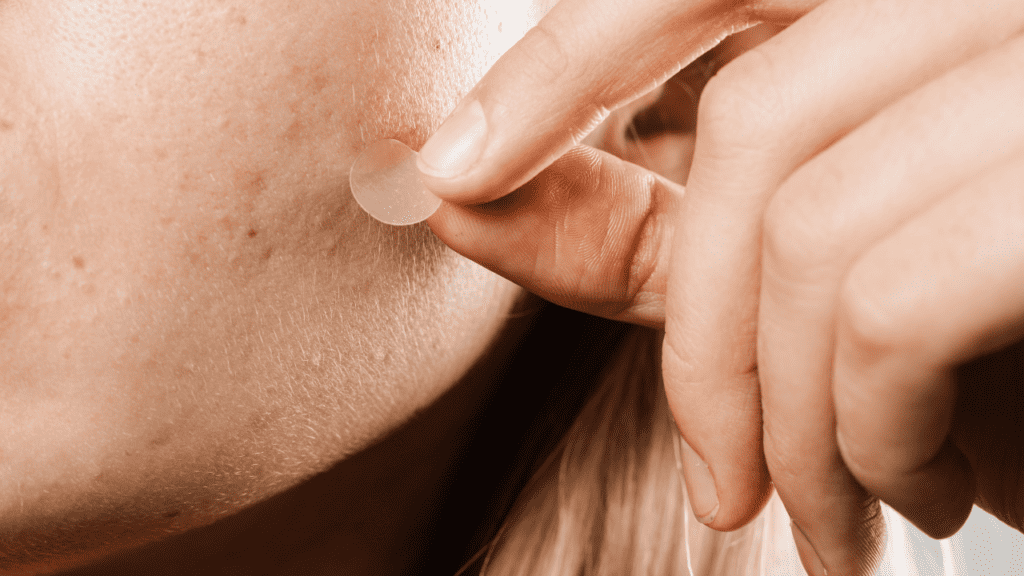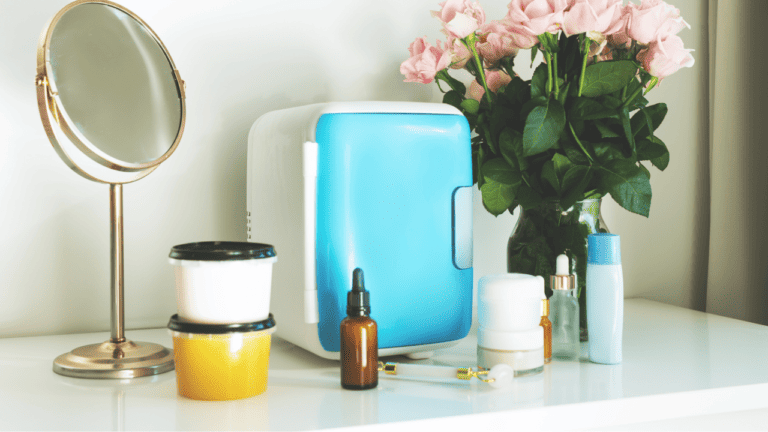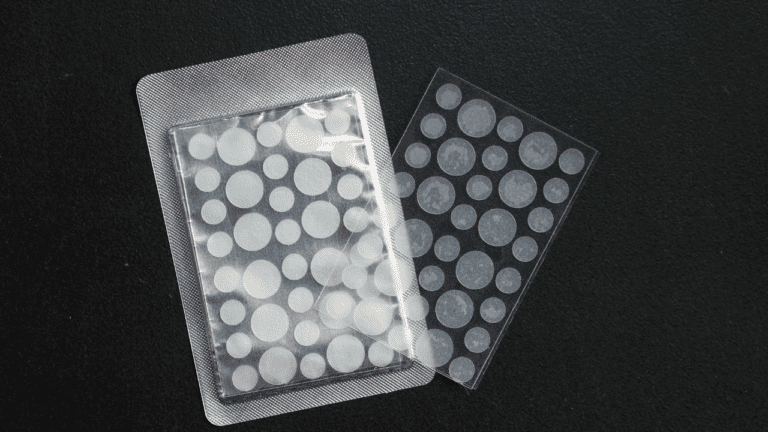Microdart pimple patches have become increasingly popular as a quick and easy solution for blemishes, especially blind pimples that haven’t come to a head. These patches work by delivering active ingredients directly, and deeper in the skin to the affected area using tiny, dissolvable needles.
However, some people may be hesitant to try these patches due to concerns about pain or discomfort. In this article, we will explore whether microdart pimple patches hurt, and provide information to help you decide if they are right for you.
Personally, we found that microdart pimple patches are generally relatively painless. Some people may experience a slight prickling sensation when applying it to their skin, but in general most users don’t find any discomfort in using them. However, depending on where you place them on the skin and the brand of pimple patch as well you may feel slightly more discomfort, especially if the brand of pimple patch focuses on having longer microdarts to penetrate the skin more deeply.
We’ll help you understand how to use microdart pimple patches effectively, safely and what you should look for when purchasing one.
Key Takeaways
- Microdart pimple patches use dissolvable needles to deliver active ingredients directly to the source of a pimple.
- While some users may experience a slight prickling sensation upon application, microdart pimple patches are generally considered to be painless.
- These patches have been shown to be effective at reducing the size and redness of pimples overnight, making them a popular choice for those seeking quick results.

Understanding Microdart Pimple Patches
Microdart pimple patches are a relatively new addition to the skincare market, and they work differently from traditional acne patches. By using tiny microdarts, these patches deliver acne-fighting ingredients directly into the skin, providing faster and more effective results.
Typically we enjoying using them because they are a solution to the blind pimples we all have an issue with.
Technology Behind Microdart Pimple Patches
Tiny dissolvable needles that penetrate the skin’s surface to deliver active ingredients. These needles are typically made from materials such as hyaluronic acid or dissolvable polymers, which are safe for use on the skin. Once the microdarts penetrate the skin, they dissolve, releasing the active ingredients into the surrounding tissue.
Microdart pimple patches typically contain ingredients such as salicylic acid, tea tree oil, and niacinamide, which are known for their acne-fighting properties. By delivering these ingredients directly into the skin, microdart patches can help to reduce inflammation, unclog pores, and prevent future breakouts.
Comparison with Traditional Acne Patches
Traditional acne patches, such as hydrocolloid patches, work by absorbing excess oil and pus from the pimple. While these patches can help to reduce inflammation and prevent further infection, they do not deliver active ingredients into the skin.
Microdart patches, on the other hand, are designed to penetrate the skin and deliver active ingredients directly to the source of the problem. This can result in faster and more effective results, as the ingredients are able to target the root cause of the acne.
Microdart pimple patches have become increasingly popular in the skincare community, particularly in the K-beauty industry. Brands such as ZitSticka have gained a following for their innovative microdart patches, which have been praised for their effectiveness in treating acne.
Overall, microdart pimple patches are a promising addition to the skincare market, offering a new and innovative way to treat acne. While they may not be suitable for everyone, they are worth considering for those who are looking for a faster and more effective way to treat breakouts.
Application and Effectiveness
How to Apply Microdart Patches
Microdart pimple patches are easy to apply and can be used as a spot treatment for acne. To apply the patch, first, clean and dry the affected area. Then, peel off the protective film from the patch and gently press it onto the pimple. Make sure the patch is properly adhered to the skin. Leave the patch on for at least six hours or overnight for best results.
Efficacy for Different Acne Types
Microdart patches are effective for treating various types of acne, including cystic acne. The patches contain ingredients such as salicylic acid, niacinamide, and tea tree oil that help to reduce inflammation, unclog pores and kill acne-causing bacteria. The microdarts on the patch penetrate the skin and deliver the active ingredients directly to the affected area, resulting in faster healing times.
It is important to note that microdart patches should not be used as a substitute for a proper skincare routine. They are meant to be used as a spot treatment for individual pimples, rather than as a preventative measure. In addition, results may vary depending on the severity of the acne.
Overall, microdart pimple patches are a safe and effective way to treat acne. They are easy to use and can provide fast relief for individual pimples.
Potential Sensations and Irritations
Do They Really Hurt?
Microdart pimple patches are designed to be gentle and non-invasive, and most people do not experience any pain or discomfort when using them. It would be scary to consistently use needles at home after all.
However, some individuals with sensitive skin may experience a slight tingling or stinging sensation upon application. What’s most important is that if at any point in time the sensation persist or becomes more severe don’t dismiss it. Perhaps you may be allergic or have a sensitivity to one of the ingredients in the patch as it penetrates the skin more deeply than a regular pimple patch
In this case, it is recommended to discontinue use and consult a dermatologist.
Managing Sensitive Skin Reactions
For individuals with sensitive skin, it is important to take extra precautions when using microdart pimple patches. Before use, it is recommended to do a patch test on a small area of skin, away from the face to check for any adverse reactions.
If redness, inflammation, or other signs of irritation occur, it is recommended to remove the patch immediately and cleanse the affected area with a gentle, non-irritating cleanser. Applying a cold compress or taking an over-the-counter anti-inflammatory medication may also help to reduce any discomfort or swelling.
In general, microdart pimple patches are considered safe and effective for most people. However, it’s better to be safe and be on the look out for any potential sensitivities or reactions.
Incorporating into Skincare Routine
Microdart pimple patches are a convenient and effective way to treat acne. They can be easily incorporated into your skincare routine and used in conjunction with other acne-fighting products.
Best Practices for Pimple Patch Use
Before applying a microdart pimple patch, it is important to cleanse the affected area thoroughly. This will help to remove any dirt, oil, or makeup that may be clogging your pores. Once the area is clean, gently pat it dry with a clean towel.
When applying the patch, make sure to center it over the pimple and press down firmly to ensure good adhesion. It is important to leave the patch on for the recommended amount of time, usually 6-8 hours, to allow the microdarts to penetrate the skin and deliver the active ingredients.
After removing the patch, gently cleanse the area again to remove any residue. It is recommended to follow up with a moisturizer to help soothe and hydrate the skin. Hyaluronic acid is a great ingredient to look for in a moisturizer, as it can help to boost hydration and promote healing.
What to Do After Removing a Patch
Once the patch has been removed, it is important to continue with your regular skincare routine. This may include cleansing, toning, and moisturizing. It is also important to avoid picking or squeezing the pimple, as this can lead to scarring and further breakouts.
Overall, microdart pimple patches are a great addition to any skincare routine. They are easy to use and can provide fast and effective relief from acne. By following these best practices and incorporating them into your skincare routine, you can help to keep your skin clear and healthy.
User Experiences and Reviews
Consumer Feedback
Many consumers have reported positive experiences with Microdart pimple patches. Reviews on Amazon show that users have found the patches to be effective in reducing the size and redness of pimples. Some customers have also reported that the patches helped to prevent the formation of new pimples.
One reviewer wrote that “these patches are amazing! They work so well and are very easy to use.” Another customer commented that “the patches are very effective and work quickly to reduce the size of pimples.”
However, some users have reported discomfort when using the patches. One reviewer noted that the patches “stung a little bit when first applied,” while another reported that the patches caused “some irritation and redness.”
Dermatologist Recommendations
Dermatologists generally recommend using pimple patches as a safe and effective way to treat acne. Dr. Mona Gohara, a dermatologist and associate clinical professor at Yale School of Medicine, recommends using pimple patches that contain salicylic acid or benzoyl peroxide to help unclog pores and reduce inflammation.
However, it is important to note that pimple patches may not be effective for all types of acne. Dr. Gohara advises that “if you have a lot of deep, cystic acne, pimple patches may not be effective and you may need to see a dermatologist for prescription-strength treatment.”
Overall, Microdart pimple patches have received positive feedback from consumers and are recommended by dermatologists as a safe and effective way to treat acne. However, users should be aware that some discomfort may occur and that pimple patches may not be effective for all types of acne.
Frequently Asked Questions
What is the effectiveness of pimple patches on cystic acne?
Pimple patches are an effective treatment for cystic acne as they help to reduce inflammation, prevent scarring, and promote healing. The patches work by creating a barrier between the pimple and the environment, which helps to prevent further irritation and infection. The patches also contain active ingredients such as salicylic acid and tea tree oil, which help to unclog pores and reduce the severity of the pimple.
How do Microdart patches compare to other treatments for cystic acne?
Microdart patches are a relatively new treatment for cystic acne, but they have been shown to be effective in clinical trials. Compared to other treatments such as topical creams and oral medications, Microdart patches are less invasive and have fewer side effects. The microdarts on the patch penetrate the skin to deliver active ingredients directly to the pimple, which helps to speed up the healing process and reduce inflammation.
Can pimple patches be used on both blind pimples and blackheads?
Yes, pimple patches can be used on both blind pimples and blackheads. Blind pimples are a type of cystic acne that occurs deep within the skin, while blackheads are caused by clogged pores. Pimple patches can help to unclog pores and reduce inflammation, which makes them an effective treatment for both types of acne. However, it is important to note that pimple patches are not a substitute for a good skincare routine and should be used in conjunction with other acne-fighting products.






